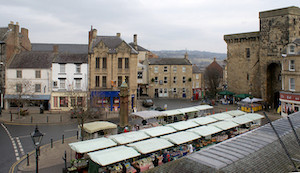Topics > Northumberland > Hexham > Hexham Parish, 1855 > Hexham Town, 1855
Hexham Town, 1855
Extract from: History, Topography, and Directory of Northumberland...Whellan, William, & Co, 1855.
HEXHAM is an ancient township and market-town, giving name to the parish and district in which it is situated. The township contains 4, 775 acres, and its rateable value is £11,005 3s. 6d. The number of its inhabitants in 1801, was 3,427; in 1811, 3,518; in 1821, 4,116; in 1831, 4,006; in 1841, 4,742; and in 1851, 5,231 souls. The manor of Hexham was sold by the Crown, in the reign of Elizabeth, to Sir John Forster, K.B., Lord Warden of the Middle Marches. In the forty-third year of the same reign, it devolved to his son, Sir John Fenwick, Knt., who purchased from the Carnabies the impropriation of the abbey. His grandson, Sir John Fenwick, Bart., sold it to Sir William Blackett, of Newcastle, in the reign of William III. It afterwards descended to Sir Waiter Calverley Blackett, Bart., and then to Thomas Richard Beaumont, Esq. and Diana his wife, being entailed on her offspring, and is now the property of W. B. Beaumont, Esq. This township is divided into four wards, Gilligate, Hencotes, Market, and Priestpopple. each of which has a separate constable, as also has each of the other quarters, or out-townships. The bridge which crosses the Tyne in this township, about a quarter of a mile from Hexham, was erected under the direction of Mr. Mylne, and is a beautiful structure, consisting of nine main arches, with smaller ones on the south side, which serve as reliefs in case of floods. A bridge was first erected here in the reign of William III. It consisted of seven arches, and was finished in 1770, but was destroyed by the great flood in 1771, when "whole acres of ground, houses, and families," are said to have been swept away. In 1774 a second bridge was commenced, but the project was soon abandoned on discovering quicksands beneath the gravel on both sides of the river. Mr. Smeaton's bridge, in 1777, was built upon Batirs d'eaux and cassons : while building, its piers were washed away by the flood of 1778, but being rebuilt, the structure was finished in 1781. It consisted of nine arches, but during a flood and hurricane, the whole was demolished on the 10th March, 1782. Notwithstanding all these misfortunes, a fourth attempt was made by Mr. Mylne, and, as above stated, the present structure was erected under his superintendence. At the junction of the Cowgarth and Cockshaw burns, in the ward of Gilligate, where the passage was often very difficult, a two arched bridge has been erected, which proves a source of great convenience to the inhabitants. The principal proprietors in this township are W. B. Beaumont, Esq., James Kirsopp, Esq., and James D. Bell, Esq. The land here is chiefly held by freehold and copyhold tenure.
HEXHAM, an ancient market-town in the above township, parish, and district, is situated twenty and a half miles west of Newcastle, forty east of Carlisle, by the Newcastle and Carlisle Railway, and 279 N.N.W. of London. It is delightfully seated along the sides of a low eminence, whose sides slope down to the Tyne, and a mile below the confluence of its two great branches North and South Tyne. The green and partially wooded eminence., delightful roads, and numerous gardens with which it is richly ornamented, backed, as they are, by the hills to the south and west, tend not a little to enhance the fertile and salubrious aspect which prevails in this neighbourhood, and well contrasts with, and enlivens the time-worn red and dingy aspect of the ancient town, with its magnificent old abbey church, or cathedral, towering above its highest houses. Hexham, like the majority of ancient towns, is very irregularly built, and the streets, with the exception of the principal ones, are narrow and confined. Priestpopple, the Battle Hill, and Hencotes, form one long street, on the south side of the town along the New- castle and Carlisle Road, which was an important thoroughfare till the opening of the Newcastle and Carlisle Railway, in 1838, since which time its traffic has considerably diminished. The Skinnerburn, anciently Bondgate, extends from the Battle Hill southwards, towards the Fell. Several narrow streets run into the market-place, which is of an irregular form, having the butter and poultry market on the south side, with piazzas in front, and, on the back part, stalls for butchers. At one end is a "pant," or reservoir, supplied with water by pipes, which are brought from about a quarter of a mile south of the town. Water, of a very superior quality, is also procured from a well on the west side of the Seal. There is, in the market-place, an ancient stone structure, formerly used as the town-hall of the bishops and priors of Hexham, and now used as the session-house. The north-west angle of the market-place opens from Gilligate, or St Giles'-street, which descends into the suburb of Cockshaw. This suburb is divided into several narrow streets, and is intersected by a burn, adjoining which are numerous tanneries and glove manufactories. The north-east angle of the market-place opens into a short street, called the Bull Bank, which is connected with Gilligate, by the Pudding-chare. In these three last mentioned streets are some of the most ancient houses in Hexharn. The archway of the Court House leads into a small street called the Hall Garth, which terminates on a terrace, commanding a fine view of the river Tyne. Here are situated a strong ancient tower and the Grammar School. On the west side of the market-place is another gateway opening into the churchyard and the Seal.










